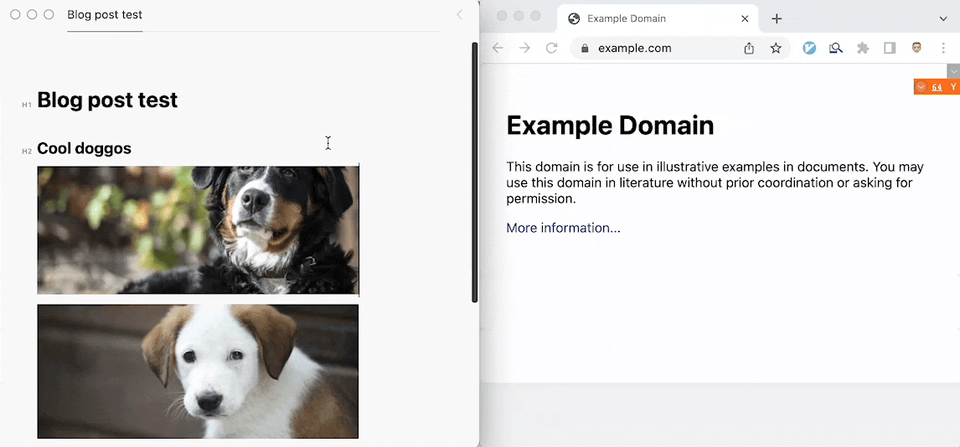
2023-05-01
To establish myself as a proper geek, my first blog post is about the blog stack itself.
There are resources on how to publish posts to Hashnode via API, but I haven’t found any with automatic upload of images.

Full source code is available on GitHub, following is just a pseudo-code.
// To obtain JWT
// 1. Open https://hashnode.com
// 2. Open DevTools
// 3. Go to Application tab
// 4. Go to Cookies
// 5. Copy value of "jwt" cookie (245 characters)
const JWT = process.env.HASHNODE_JWT;
// To obtain Publication ID
// Go to https://hashnode.com/settings/blogs
// Click on "Dashboard" button of the blog you want to upload to
// Copy ID from the URL, e.g. https://hashnode.com/<id>/dashboard
const PUBLICATION_ID = process.env.HASHNODE_PUBLICATION_ID;
// To obtain Hashnode API token
// 1. Open https://hashnode.com/settings/developer
// 2. Click on "Generate New Token" button or use the existing one
const HASHNODE_TOKEN = process.env.HASHNODE_TOKEN;
if (!JWT || !PUBLICATION_ID || !HASHNODE_TOKEN) {
console.error("Please fill in the required environment variables")
throw new Error("Please fill in the required environment variables")
}
const docPath = process.argv[2] // e.g. /path/to/markdown.md
const rootDir = process.argv[3] ?? '' // e.g. /users/<username>/documents/blog – important when assets paths are absolute within rootDir, as Nota app does
if (!docPath) throw new Error("No document path provided")
const docDirname = path.dirname(docPath) // e.g. /users/<username>/documents/blog/2022
const docBasename = path.basename(docPath, ".md") // e.g. My Blog Post
const docContent = fs.readFileSync(docPath, "utf-8")
let docContentModified = docContent // starts as a copy of a the original, will be modified in-place
const imagePaths = getImagesFromMarkdownDoc(docPath)
const imageUrls = [] // will be populated with URLs of uploaded images
for (const imagePath of imagePaths) {
const imageType = path.extname(imagePath).slice(1) // e.g. `png` or `jpg`
const imageFullPath = imagePath.startsWith(`/`)
? path.join(rootDir, imagePath) // Some apps, like Nota, use absolute paths within rootDir, like `/assets/image.png`
: path.join(docDirname, imagePath) // Other apps, like Typora, use relative paths, like `./assets/image.png`
// 1. Get info from Hashnode about Amazon S3 bucket where to upload the image
const metaRes = await fetch(`https://hashnode.com/api/upload-image?imageType=${imageType}`, {
"headers": {
cookie: Object.entries({
jwt: JWT,
// Following seems to be important, but it's really not
// 'hn-cookie-username': '...',
// 'hn-user': '...',
}).map(([key, value]) => `${key}=${value}`).join("; "),
},
});
const {
url, // https://s3.amazonaws.com/cloudmate-test
fields // { key, bucket, X-Amz-Algorithm, X-Amz-Credential, X-Amz-Date, ... }
} = await metaRes.json()
// 2. Upload image to provided Amazon S3 bucket
const formData = new FormData();
for (const [key, value] of Object.entries(fields)) formData.append(key, value)
formData.append("file", fileFromSync(imageFullPath))
const uploadRes = await fetch(url, {
method: "POST",
// Weirdly, correctly setting content-type to multipart/form-data will case `The body of your POST request is not well-formed multipart/form-data.`
// headers: { "content-type": "multipart/form-data;" },
body: formData
})
if (uploadRes.status !== 204) {
console.log("Upload failed!")
console.log(await uploadRes.text())
continue;
}
const imageCdnUrl = `https://cdn.hashnode.com/${fields.key}`;
console.log(`Upload success! ${imageCdnUrl}`)
imageUrls.push(imageCdnUrl)
// 3. Replace the local image path with the CDN URL
docContentModified = docContentModified.replace(imagePath, imageCdnUrl)
}
// Save the modified Markdown file, uncomment for debugging purposes
// fs.writeFileSync(docPath + `.modified.md`, docContentModified, "utf-8")
// 4. Publish modified Markdown file to Hashnode
const publishRes = await fetch('https://api.hashnode.com', {
method: 'POST',
headers: {
'Content-Type': 'application/json',
Authorization: HASHNODE_TOKEN,
},
body: JSON.stringify({
// TODO: Create as Draft by default
query: `
mutation createPublicationStory($input: CreateStoryInput!, $publicationId: String!) {
createPublicationStory(input: $input, publicationId: $publicationId) {
success
post {
cuid,
slug,
title,
dateAdded,
publication {
domain
}
}
}
}
`,
variables: {
publicationId: PUBLICATION_ID,
input: {
title: `${docBasename}`,
contentMarkdown: docContentModified,
// Available tags: https://github.com/Hashnode/support/blob/main/misc/tags.json
tags: [],
coverImageURL: imageUrls[0], // first image as Cover - not great, not terrible
},
},
}),
}).then(res => res.json())
if (!publishRes?.data?.createPublicationStory?.success) {
console.log("Publish failed!")
console.log(publishRes)
process.exit(1)
}
// 5. Open the published post in the browser
const url = `https://hashnode.com/edit/${publishRes.data.createPublicationStory.post.cuid}`
console.log(`Published to ${url}`)
execSync(`open ${url}`)
// TODO: Use proper parser, like markdown-it or remark
function getImagesFromMarkdownDoc(filePath) {
const doc = fs.readFileSync(filePath, "utf-8")
const images = doc.matchAll(/!\[(.*)]\((.*)\)/g) // capture both image title and path, for future
return [...images].map(match => match[2]) // but return only the paths for now
}